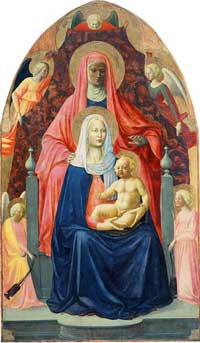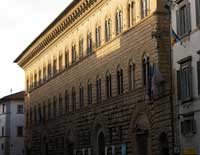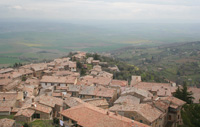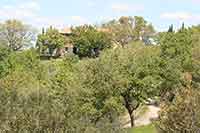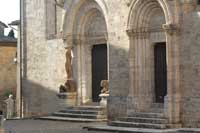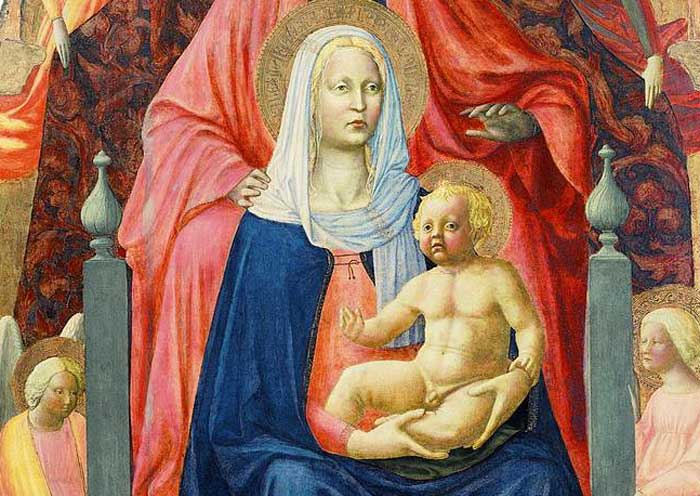 |
|
| I T |
Masaccio and Masolino da Panicale, The Madonna and Child with Saint Anne (detail), 1424, tempera on panel, 175 x 103 cm, Galleria degli Uffizi, Florence |
Masaccio and Masolino da Panicale | The Madonna and Child with Saint Anne |
| In Florence the new age of the Renaissance began in painting with a rather subdued work, devoid of any rhetoric: The Madonna and Child with Saint Anne executed by Masolino and Masaccio in 1424. The structure of this work is simple yet extraordinarily monumental. The succession of planes is compact and follows an upward direction, thus creating a pyramid shape. The composition can certainly attributed to Masaccio who executed only the Madonna and Child and the two angels (the upper right-hand one, and the one looking down from on high). A sense of grave dignity and power emanates from the faces, from the expressions and from the solidity of the bodies. |
The Madonna and Child with St. Anne, also known as Sant'Anna Metterza, is a painting by the Italian Renaissance painter Masaccio, probably in collaboration with Masolino da Panicale, c. 1424.The Virgin and Child, with its powerful volume and solid possession of space by means of an assured perspectival structure, is one of the earliest works credited to Masaccio. But for one, the angels, very delicate in their tender forms and pale, gentle colouring, are from the more Gothic brush of Masolino; the angel in the upper righthand curve reveals the hand of Masaccio. The figure of St. Anne is much worn and hence to be judged with difficulty, but her hand, which seems to explore the depth of the picture-space, may well be an invention of Masaccio. The ‘Madonna and Child with Saint Anne’ was originally commissioned for the Sant’Ambrogio church in Florence. According to Vasari, “It was placed in the chapel door which leads to the nuns’ parlour”. The figure of Christ is that of a young child, a realistic presence, rather than a gothic cherub. This is also one of the first paintings to display the effect of true natural light on the figure; it is this invention which imparts the modelling of form so characteristic of Masaccio, and which would have a profound influence on the painting of the Italian Renaissance. |
 |
||||
Masaccio e Masolino da Panicale, La Madonna col Bambino e sant'Anna (detail), 1424, tempera su tavola, Galleria degli Uffizi, Firenze [4]
|
||||
|
||||
Palazzo Medici Riccardi, Florence
|
Arcidosso |
Montalcino | ||
Art in Tuscany | Galleria degli Uffizi, Florence |
||||
|
This article incorporates material from the Wikipedia article Madonna and Child (Masaccio) published under the GNU Free Documentation License. |
||||
Set in the hills above the Ombrone Valley with views that stretch down to the coast 20 miles away from its lofty position is the thoughtfully renovated Podere Santa Pia. Podere Santa Pia provides for a truly relaxing and authentic experience of living the ‘Italian dream’. This wonderful holiday house is the ideal base to enjoy authentic Tuscany, including its tastes and flavours. There is direct access from the kitchen onto the terrace, ideal for al fresco dining and relaxing in the shade. Italy's Tuscany region offers the visitor such a feast of culinary delights it really is difficult to know where to start. If you love great wines, great food and great scenery, a wine tasting tour makes an ideal holiday. Going wine tasting in Tuscany is practically an obligation in this region of rolling vineyards and hidden, historic wine-properties. Tuscany is filled with world-renowned wine regions, and although Santa Pia is off the beaten track it is the ideal choice for those seeking a peaceful, uncontaminated environment, yet still within easy reach of the the famous Tuscan wines. Treasures in southern Tuscany |Podere Santa Pia |
||||
Podere Santa Pia |
Podere Santa Pia, garden view, April |
View from Podere Santa Pia
on the coast and Corsica |
||
Podere Santa Pia |
Podere Santa Pia, garden view, December |
San Qurico d'Orcia |
||
|
||||
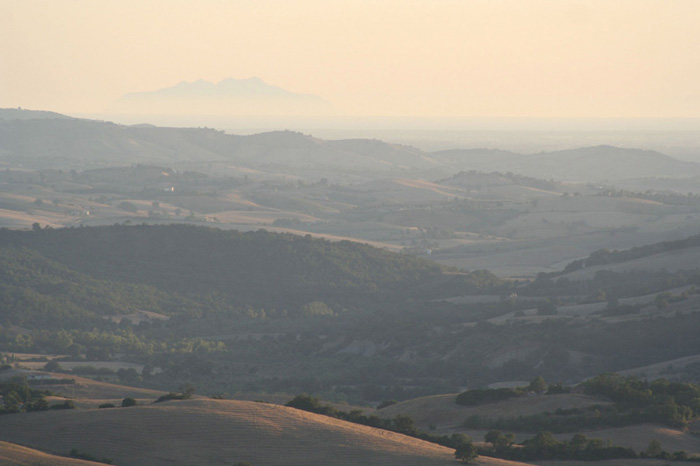 |
||||
Podere Santa Pia, with an extraordinary view of the rolling Tuscan hills, up to the seaside and Montcristo. |
||||

